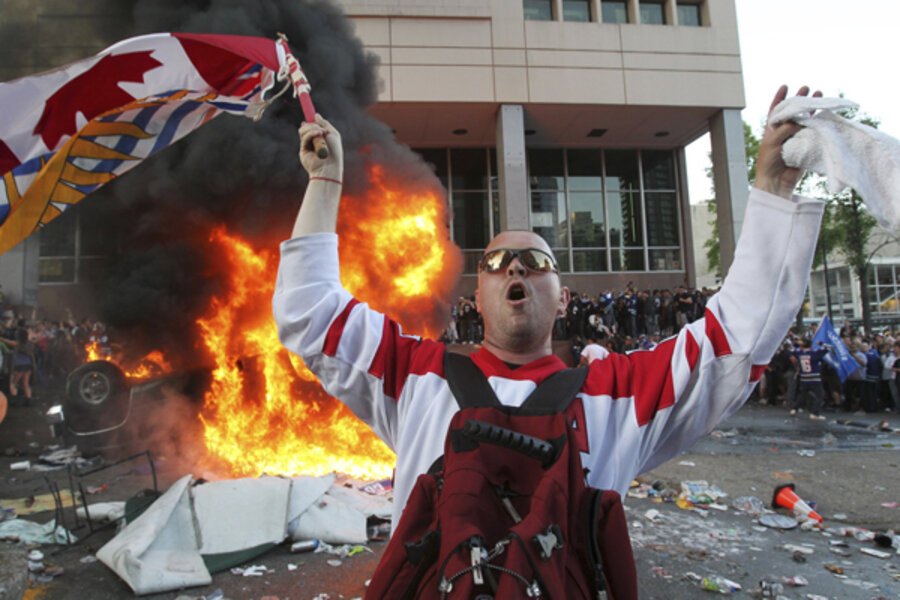Canadians use social media to out Vancouver rioters
Loading...
| Toronto
Canadians were outraged when mobs rampaged through downtown Vancouver after the Canucks hockey team lost the Stanley Cup championship earlier this month. Now, that outrage has found what some observers see as a dangerous new outlet, through dozens of social media sites dedicated to outing and punishing the rioters.
The sites include photos and videos of people doing everything from breaking shop windows to trying to set a police car on fire to looting luxury goods stores. They name names, post telephone numbers and addresses, and sometimes include threats and racist and homophobic language. And they have provoked outrage on their own among those who warn that they are part of a new and even more dangerous type of online mob promoting a culture of mass surveillance.
“It resembles a public lynching where you have mobs of people taking justice into their own hands,” says Alexandra Samuel, a social media expert at Emily Carr University in Vancouver. ““There are lots of governments in the world who will be very interested in using this as a model.”
Social media is already used in individual cases to “out” presumed wrong-doers, from Facebook pages that reveal the bad behavior of an ex-partner to websites that name known sex offenders. But social media experts say this is the first time an entire community has used the tools to do what is normally considered the work of the police and the justice system.
Among those named are Nathan Kotylak, a 17-year-old high school senior and Olympic hopeful and member of Canada’s junior men’s water polo team; Robert Snelgrove, a 24-year-old downtown Vancouver resident; and Camille Cacnio, a biology student at the University of British Columbia. It is not known whether any of them have been charged with an offense, but they have already suffered serious consequences.
Mr. Kotylak was pictured stuffing a rag into the gas tank of a police car and trying to light it on fire. His identity would normally be protected under Canada’s young offender laws, but after he was named, he asked for a court injunction so he could publicly apologize. He was suspended from the water polo team. His father, a medical doctor, temporarily shut down his medical practice, and the family left their home in Maple Ridge, B.C., for a few days after their address appeared online and they received threats.
Mr. Snelgrove’s friends exposed him on a social media site after they saw television news pictures of him looting during the June 15 riot. He told The Vancouver Sun newspaper that he received “dozens and dozens … of downright hateful” messages, some that said “go die, go jump off a bridge, and homophobic comments.”
Ms. Cacnio, who was captured on video stealing two pairs of men’s pants from a clothing store, was fired from her part-time job and published a lengthy apology on the Internet.
“Being a part of the riot was simply to fulfill the adrenaline rush I was looking and hoping for – an adrenaline rush that I previously got from post-winning games,” she wrote. “I had no intentions of defiling the city. I love Vancouver as much as you do – I’ve lived here since I was 7 months old. But in my immature, intoxicated perspective all I saw was that the riot was happening and would continue happening with or without me, so I might as well get my adrenaline fix.”
Jeromie Williams, an “administrator” for one of the social media sites, the Facebook group “100,000 strong to ban Nathan Kotylak from the Canada Olympic team,” says the aim of the group was to make sure that Kotylak does not represent Canada in the Olympics, since “his actions don’t reflect Canadian values.”
But he says contributors also want retribution and the toughest possible sentences for the rioters, and do not trust the justice system will act harshly enough.
“The general feeling is that these people are guilty,” he says. “If Nathan Kotylak isn’t convicted or if he strikes a plea bargain, there has to be a backup plan and the group is that backup plan.”
The post-game riot was heavily documented with cellphone cameras, and the Vancouver Police Department initially asked the public to send them any pictures or videos through anonymous social media sites. Last week, it issued a statement warning of a growing danger that social media could be use to mete out vigilante justice and asking people to “resist the temptation to take justice into their own hands.”
Criminologist Robert Gordon, who heads the International Cyber Crime Research Centre at the University of British Columbia in Vancouver, says there is no way to stop people from collectively using social media as a form of punishment since there is no effective way to police the Internet. He says that in this case, people are angered and embarrassed by the riots and do not want to wait for months while individual cases work their way through the courts.
“The population isn’t interested in intellectual arguments about whether it’s appropriate,” he says. “They’re saying, ‘Why do we need a trial when we can see very clearly what this person was doing. What’s his argument going to be?’”
But Ms. Samuel argues that allowing what amounts to an “online mob” to continue sets a dangerous precedent for how social media can be used, and could lead to a new kind of police state. She says that images posted on social media could easily be altered and should not be taken as hard evidence, and adds that by using social media as a form of justice, “we are legitimizing the idea that law enforcement should be able to do what it wants.”
“Precisely because social media is such a powerful tool of mass mobilization," she says, "it has the potential to turn selective cooperation with law enforcement into a mass culture of surveillance."
Related video:
[ Video is no longer available. ]





